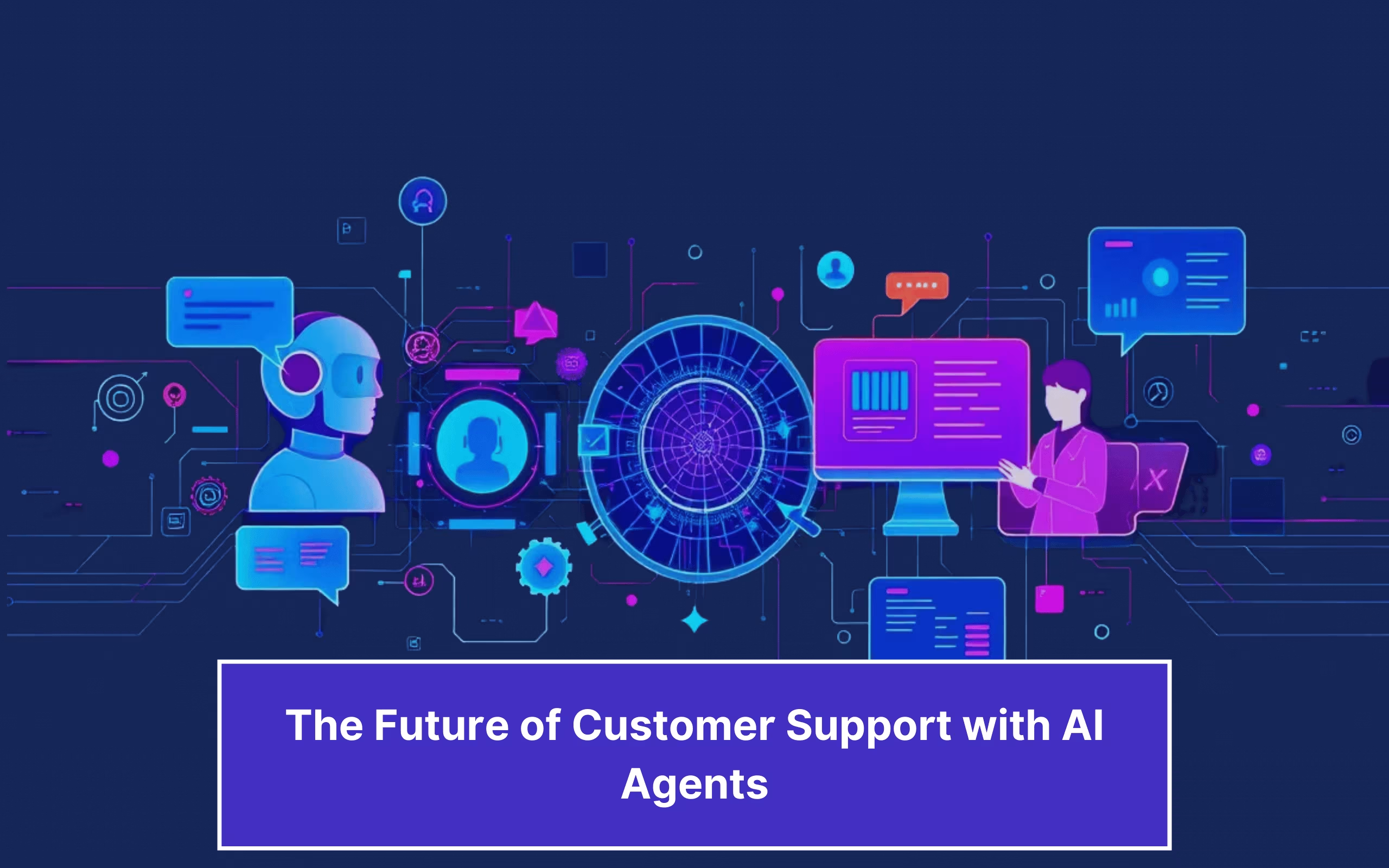Updated on April 17, 2025

Introduction
A 2016 study by Inc. showed that 51% of consumers expect businesses to provide 24/7 support and service. However, while businesses want to offer customers round-the-clock support, it’s challenging to hire and train a dedicated 24/7 support team.
This is where AI chatbots come in. Research shows that businesses can address customer queries and provide support 24/7, with the help of AI chatbots, while saving billions on operational costs.
There is no doubt that customer service is on the cusp of massive change, thanks to the emergence of AI agents that can deal with challenges autonomously without the need for human supervision. These agents are not just good at their job, but they constantly get better because they are always learning. They are capable of dynamic learning, allowing them to use context clues and data from past exchanges to improve the support they provide consumers constantly.
In this piece, we will discuss:
- Enhanced Natural Language Understanding and Generation
- Multimodal Interaction Capabilities
- Proactive and Predictive Support
- Emotional Intelligence and Sentiment Analysis
- Continuous Learning and Adaptation
- Integration with Augmented Reality (AR) and Virtual Reality (VR)
- Ethical Considerations and Data Privacy
1. Enhanced Natural Language Understanding and Generation
Today’s AI agents can function autonomously without the need for human intervention. These AI agents have Machine Learning and Natural Language Processing abilities that allow them to process queries and respond to simple or complex issues without human intervention.
Their ML and NLP capabilities let them refer to context clues and previous exchanges to learn and tweak their responses constantly.
AI agents of the future will be able to use their large language model training to provide customers with multilingual, human-like, round-the-clock support. While it’s impossible for one human agent to address customer queries in many languages, multilingual chatbots can quickly close communication gaps while substantially reducing operation costs.

2. Multimodal Interaction Capabilities
Unlike traditional AI agents that base their responses on one form of data input, be it text or images, the future lies in the virtual hands of multimodal AI agents that simultaneously process images, audio, and textual data to generate responses. Text, voice, and visual input integration can provide customers with a seamless experience. This allows AI agents to meet customers’ needs and wants using their preferred mode of communication.
The multiple forms of data would also improve understanding of customer needs and expectations. Integrating multimodal AI agents also means improved accessibility as it would let customers approach agents according to their needs and capacities. It would allow agents to analyze various forms of input to provide customers with customized responses while allowing for reduced wait times for resolutions.
3. Proactive and Predictive Support
Predictive analytics would also play a massive part in shaping the role of AI agents in customer service. By reviewing clients’ historical data, analyzing context clues, and reading current behavior and responses, AI agents would recognize patterns and anticipate challenges before they occur while offering proactive, personalized solutions. Further, predictive analytics would allow agents to predict and serve customer needs before sharing them. This would help clear bottlenecks, reduce the effort the customer needs to put into resolving queries and increase consumer satisfaction overall.
4. Emotional Intelligence and Sentiment Analysis
In the future, AI agents will become more and more adept at analyzing customer emotions and reacting accordingly. They can analyze the tone of voice or text, linguistic details, and sentiment in real-time. This will allow them to respond appropriately and empathetically when the customer becomes annoyed or angry.
When it detects annoyance in the tone and behavior of customers, AI agents will quickly adopt measures to help reduce the customer’s frustration. They can do this by offering alternate solutions and aligning their responses that meet customer’s needs more satisfactorily, thereby improving overall service quality. AI agents will also be able to recognize patterns in customer’s behavioral data from past interactions and adapt their own responses and language, much like a human would while dealing with different customers.
Another crucial tool that will become integral in customer support in the future is sentiment analysis. The tech is rooted in machine learning and natural language processing, and it will be able to scour through customer feedback, chats, reviews, social media comments, etc, to offer insights into how customers genuinely feel about a brand.
These tools will identify customer sentiments and categorize their reactions to products, services, or brands. This categorization will help support teams address issues and challenges before they occur. Businesses can use sentiment analysis tools to proactively identify negative trends in feedback and customer sentiment regarding products or services to address the concerns before they become significant issues.
5. Continuous Learning and Adaptation
AI agents will be learn about customers with each new interaction and tweak their behavior and responses accordingly. They could also use predictive analytics to anticipate needs and wants. This would allow them to redesign service experiences according to customer’s preferences. The future of AI agents, thus, lies in personalized support as it employs dynamic learning with each interaction and analyzes the data to enhance customer experiences and increase satisfaction with every new engagement.
6. Integration with Augmented Reality (AR) and Virtual Reality (VR)
In the future, customer support will increasingly depend on augmented reality (AR) and virtual reality (VR) to offer customers the best service experiences. The integration of AR and VR in consumer support will offer interactive ways to offer solutions to customers. What this tech offers goes beyond traditional methods of customer support. Instead, of just depending on audio or textual support, this would offer immersive and experiential assistance.
Using augmented reality tech, customer support agents can assist customers in setting up products or with troubleshooting products by directly overlaying info on their devices. This way, the need for agents to visit the customer or the customer to visit support centers nearly vanishes as, with AR, agents can directly demonstrate how to set up or troubleshoot a product by overlaying digital images onto real spaces. This would significantly reduce the amount of time and effort required on both sides to resolve an issue, no matter how complex.
Virtual reality in customer support would also come in extremely handy in providing customers with immersive experiences where they can interact with and learn about products in controlled virtual environments. With the help of VR, customers would be able to get a full demonstration of the look and feel of a product or service before making a purchase.
The integration of AR and VR in customer support, thus, offers extremely efficient and experiential solutions that can change the face of customer support as we know it. Instead of traditional text or audio-based interactions, this tech would offer highly immersive ways to support customers as they learn about, set up, or troubleshoot their products.

7. Ethical Considerations and Data Privacy
When using AI agents in customer support situations, it gives rise to crucial questions of ethics and data privacy. Accountability, transparency, and ethics become especially important considerations in such scenarios. Businesses must responsibly collect and use data while ensuring that they are fully transparent to consumers about what data is being collected. They must also give full disclosure on what they would use such data for and collect only what is necessary while taking strong security measures to avoid the chances of information breaches and adhering to proper privacy regulations.
Further, companies must ensure that customers understand how their data will be used and be offered the choice to opt-out if necessary. When companies are transparent about what data they are collecting and how AI is being used to shape customer experiences, customers will be more willing to place their trust in said companies.
To ensure ethical use, data collected should be anonymous to protect individual consumers’ privacy whenever possible. Companies must also monitor scenarios where bias in the algorithm can cause AI agents to inadvertently interact in a discriminatory manner against certain communities and customer groups. Finally, human agents should be at the ready to take over and oversee complex queries, especially in situations where the AI agents may misinterpret customer intent, which could lead to poor service and customer experience.
Conclusion
The integration of AI agents will, thus, continue to transform customer support as we know it. As AI agents evolve in the future, they will make use of dynamic learning and new large language models to meet customers’ growing needs before they even arise. Predictive analytics will allow them to recognize patterns in customer behavior and expectations to offer proactive and personalized support while sentiment analysis will allow the space for recognition of trends in customer feedback to address product and service challenges before they become major issues. As AI-driven customer support progresses to deliver empathetic and efficient results, businesses must also strive to adapt to the oncoming technological revolution if they are to stay ahead of trends.

CEO & Co-Founder of Kommunicate, with 15+ years of experience in building exceptional AI and chat-based products. Believes the future is human + bot working together and complementing each other.





